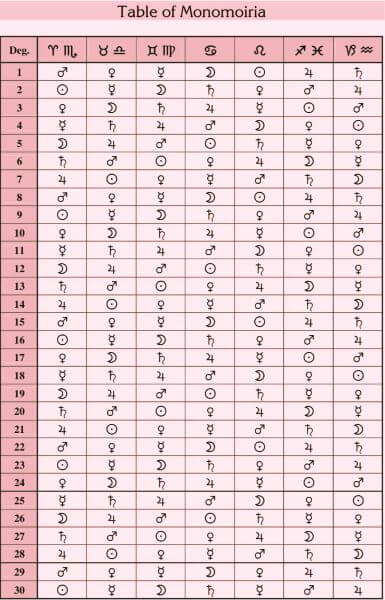Degrees of the Zodiac - history, symbolism and meaning.
Degrees of the Zodiac – history, symbolism and meaning.
Why are the degrees of the Zodiac special?
Astrology is not only the observation of signs and planets, but also fine adjustments in the very structure of the Zodiac. Each sign has 30 degrees, so the entire Zodiac encompasses 360 degrees. But each of those 360 degrees has its own nature and meaning.
While the sign gives the basic energy (eg Aries – impulse, Cancer – sensitivity, Capricorn – structure), the degree introduces micro-nuances and gives additional specificity. In this way, astrology gains depth and precision – because it is one thing to be born in the sign of Leo, and quite another at, say, 5° Leo or 28° Leo.
It was this idea that led to the development of a system that associates each degree with a planet or symbol, and it has been a subject of study for two thousand years.
Historical development
Hellenistic period
In ancient Greece and Alexandria, astrologers developed a system called monomoiria. It is the division of each sign into degrees, each degree being ruled by a certain planet. In this way, within one sign we get the “micro-rules” of the planets.
Thus, astrologers believed that fate is not only in the sign and planet, but also in the degree in which the planet is located.
Arabs and the Middle Ages
Arab astrologers (especially during the 9th–12th centuries) continued this tradition. Their
works, translated into Latin, were the basis of European astrology in the Middle Ages. They further enriched the symbolism of degrees and began to use degrees in predictive astrology (eg in horary astrology).
Renaissance and later development
During the Renaissance, astrology experienced a new boom. Degrees acquired more and more symbolic meanings – from numerological to esoteric. Systems such as the Sabian symbols originate from there, which give each degree a special image and vision.
Ashmand and his version
Thomas Taylor Ashmand (better known as Ashmand) was an English translator and researcher of Hermetic and ancient texts from the late 18th and early 19th centuries. His works are significant because he translated and popularized many Greek and Egyptian sources in the fields of astrology and philosophy.
Tables of degrees appear in his translations and commentaries, which he associated with
planetary rulers. In this way, the was brought back into use by Western astrologers.
Later, other systems were developed (eg the Sabian symbols of Elsie Wheeler and Mark Jones in the 20th century), but Ashmand’s version was an important bridge between ancient astrology and modern interpretations.
The difference between ordinal numbers and Zodiac numbers
One of the key problems for beginners is understanding the difference between an ordinal number and a Zodiac degree number.
In mathematics:
1 is the first number,
2 is the second, etc.
In astrology:
0° Aries marks the first degree of the Zodiac,
1° Aries signifies the second degree of the Zodiac,
2° Aries signifies the third degree of the Zodiac.
Therefore, 0° in the Zodiac = 1st degree, and by no means “zero” in the sense of emptiness.
Why? Because degrees are not mere numbers, but symbolic units of energy. Each degree has its own identity, ruler and meaning. Mathematically, “0” is absence, but in astrology, “0°” signifies the beginning of manifestation – that’s why 0° Aries carries tremendous symbolism of birth, breakthrough, and a new cycle.
Degree interpretation (in relation to the table)
The table clearly shows that each degree has its own planetary ruler. This means that the planet that is on that degree gets an additional “color” from the ruler of the degree.
For example:
0°–0°59′ Aries = 1st degree of the Zodiac, ruled by Mars. If Venus is there, she becomes much more “belligerent” and impulsive.
15° Cancer = 16th degree of the Zodiac, ruled by Venus. If the Moon stands there, its sensitivity is further emphasized and enriched by the harmonious energy of Venus.
29° Pisces = 30th degree of Pisces, ruled by the Moon. This is the completion of the cycle, a
degree that carries a strong emotional and intuitive charge.
In this way, monomoiria bring a fine nuance to the interpretation of the birth chart.
Jung and the symbolism of degrees
Carl Gustav Jung was one of the few great psychologists who seriously studied astrology. For him, astrology was the symbolic language of the collective unconscious.
Jung believed that numbers and symbols – including the degrees of the Zodiac – are expressions of archetypes. He did not see degrees as mere mathematics, but as symbolic keys that unlock unconscious contents
This is precisely why even today in Jungian astrology degrees are interpreted as archetypal messages – e.g. 0° Aries as the Hero archetype starting the journey, or 29° Pisces as the Return to Source archetype.
The degrees of the Zodiac represent the finest layer of astrological analysis. They combine: historical tradition (from the Greeks and Arabs, through Ashmand, to modern astrologers), symbolism and numerology (numbers as bearers of meaning), psychology (Jung’s view of archetypal language).

